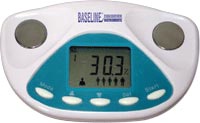Home » Hospital & Durable Medical Equipment » Body Fat Monitor & Body Fat Analyzers » Body Fat Monitor & Body Fat Analyzers
Body Fat Monitor & Body Fat Analyzers
Knowing the weight of a patient is a very important diagnostic tool, but it does not tell the whole story. Many things could give a false weight, making a patient numerically to be overweight or obese even though he is physically fit. In order to see the whole picture, the doctor needs to take the composition of the types of tissues in the patient's body. This can easily be done in the office with a body fat monitors and body fat analyzers.
The real problem with obesity is not the fact that the person is overweight but that he is over-fat. Because muscle is very compact and weights more than fat, a supreme athlete, according to a doctors' scale or body mass index might be considered overweight or obese, but in reality, his body may only house 8% fat. It is really the body composition that determines obesity rather than simply the overall weight. Using a body fat monitors and body fat analyzers can help the practitioner to determine if such is the case.
Body fat monitors and body fat analyzers can also determine if the patient has enough fat for good health. They can give the practitioner a clue as to reasons behind abnormal hormone levels in a seemingly healthy person. Body fat percentage has been linked in some studies to testosterone and estrogen levels in humans. Too little body fat, below about 5% for men or 12% for women, could interfere with the proper functioning of these important hormones that control so much more than just sexual characteristics. Careful use of a Body body fat monitors and body fat analyzers a way that can help the physician advise the patient as to whether or not his body composition is healthy or not.
Most body fat monitors and body fat analyzers work in the same way, through Bioelectrical Impedance Analysis. This works by sending an electrical impulse through the body when the patient stands on the unit barefoot. When the signal returns to the reader, it analyzes how well the current was conducted through the body and uses that data to come up with a body composition. Some body fat monitors and body fat analyzers do not have a scale to gage weight as well, but some do, and for many patients, these are preferable since they do not have to take multiple readings for their weight and body composition. Having an all in one body body fat monitors and body fat analyzers in the office saves both floor space and time for the physician and the patient. It will open up more time during which the examination can take place. By streamlining the admission and data-gathering process, the patient will not feel as poked and prodded, as many often complain of feeling when they visit their physicians.
The days of just weighing a patient upon entry for a consultation are dwindling. Now, in order for a physician to fully understand their patient's health, he must know the percentages of tissues of which the patient's body is composed. In order to do so, it is vital for a practitioner to have body fat monitors and body fat analyzers available in his office to get more of the story than simply weight alone can tell.













 Unit: single
Unit: single


